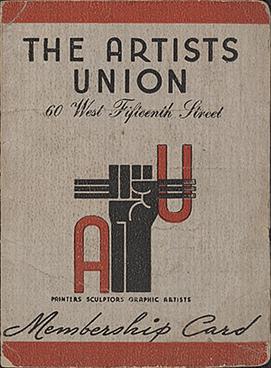Artists Union

|
|
| Merged into | Artists League of America |
|---|---|
| Formation | 1933–34 |
| Extinction | May 1942 |
| Type | union |
| Purpose | employment for artists |
| Headquarters | 60 West Fifteenth Street |
| Location |
|
|
First president
|
Byron Browne |
|
First secretary
|
Bernarda Bryson |
|
Formerly called
|
Emergency Work Bureau Artists Group Unemployed Artists Group |
The Artists Union or Artists' Union was a short-lived union of artists in New York in the years of the Great Depression. It was influential in the establishment of both the Public Works of Art Project in December 1933 and the Federal Art Project of the Works Progress Administration in August 1935. It functioned as the principal meeting-place for artists in the city in the 1930s, and thus had far-ranging effects on the social history of the arts in America.
The Artists Union started in September 1933 as a group of about twenty-five artists who worked for the Emergency Work Bureau, which was soon to be shut down. The group met informally at the John Reed Club and was at first called the Emergency Work Bureau Artists Group, though this was soon changed to become the Unemployed Artists Group. The secretary of the new group was Bernarda Bryson, who had been involved with the Unemployed Councils of the American Communist Party. On 27 October 1933 the group was among the leaders of some three hundred artists who attended a symposium on unemployment at the College Art Association, where they demanded state-funded relief work for artists. In December 1933 the group petitioned Harry L. Hopkins, the administrator of the Civil Works Administration, to provide work in various artistic fields to all unemployed artists. The Public Works of Art Project was established later in the same month.
The administrator of the PWAP for New York was Juliana Force, who was director of the Whitney Museum of American Art. She asked major artists' associations to provide lists of their unemployed, but did not contact the Unemployed Artists Group. On 9 January 1934 the group picketed the Whitney with placards targeting the director, the first of a series of protests. The administration responded with offers of jobs, and it became accepted that artists should be included in the government's work-relief plan.
...
Wikipedia
